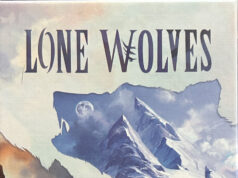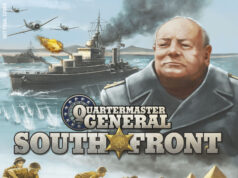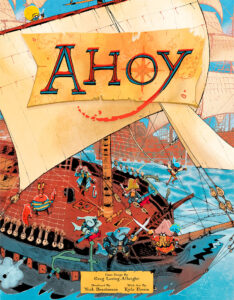 Avast, ye scallywags! Things be lookin’ fishy on the Seven Seas… The Mollusk Union are tryin’ ta make the Bluefin Squadron walk the plank! Shiver me timbers! It’s the Smugglers with a STEEL CHAIR!
Avast, ye scallywags! Things be lookin’ fishy on the Seven Seas… The Mollusk Union are tryin’ ta make the Bluefin Squadron walk the plank! Shiver me timbers! It’s the Smugglers with a STEEL CHAIR!
Ahem, sorry, I’m not sure where that came from… Since first playing Vast several years ago, I’ve been intrigued by asymmetric games. They were such games before then, but it was Vast that brought them to my attention. Some work and some fall flat on their proverbial faces. When I was told about Ahoy and that it was an asymmetric game from the publisher of Vast with a similar art style, I was instantly intrigued (that it contained the words “Mollusk Union” also helped). Would it be a successful take on the genre, or would it fall into the latter category? I had to find out. It is a game for 2-4 players, and it plays about 60 minutes, though it can come in quite a bit shorter if you’re only playing it with 2 players. The best experience happens to be with 2 players as well.
Gameplay Overview:
As I mentioned, the game is asymmetric, but only mostly so. Two of the players play the game the same way, and the win condition is the same for all four. The players take on the roles of the Bluefin Squadron, the Mollusk Union, or the Smugglers. The three all play differently, but there can be two Smugglers players. Ultimately, the goal is the same no matter your role: spread your wealth and reputation to acquire the most Fame by the end of the game. The rulebook makes it a little more specific for those that like terminology. The Bluefin Squadron and Mollusk Union are using area control, while the Smugglers are picking up and delivering.

The gameplay is fairly simple. At the beginning of each round, everyone rolls dice matching their faction’s color. Then, you take turns placing two of those dice into slots on your dual-layer player board to take various actions. These actions are mostly moving around the board, but also are other tasks such as preparing your cannons for battle, or recruiting crew, depending on faction. There are additional actions that do not take a die on crew cards, which you can take any number of on a turn if you acquire them.
While the gameplay differs for the three factions, it follows some similar patterns. At the start the board is small: only two 2×2 ocean tiles. To accumulate Fame, you need to move around to explore and place additional ocean tiles. The Bluefin Squadron seeks to spread its patrol boats around to build Strongholds. The Mollusk Union is attempting to generate many comrades and spread them out across the board. The Smugglers both are just trying to find cargo and sell it for fortune and glory. Universally, you can recruit crew at the islands and can engage in combat with your opponents (which can yield gold and limit their action choices).
The goal of accruing the most Fame is achieved differently by the area control players and the Smugglers. The Smugglers gain Fame by buying and selling cargo, which increases the wealth of each region. The Bluefin Squadron and Mollusk Union vie for control of each of the regions, and gain Fame based on each region they have greater control over. Once one or more players end a round with 30+ Fame, the game ends.

Game Experience:
Most of your turns go very quickly. Often you are just moving your Flagship or using the Tailwind action to move around the board. This makes it pretty easy to plan out your turn so you can act very quickly when it comes around to you. The 2-player game, in particular, is very short as a result. There are moments where things do take a bit longer (resolving combat), or you have a slightly bigger decision (selecting crew to recruit at an island). As you go later into the game and you have more crew available on your ship, your options do get a bit broader too. In combination with the board being progressively larger (11 tiles, which is the maximum, is pretty big!), this leads to a much more complex game and set of decisions in the later rounds.
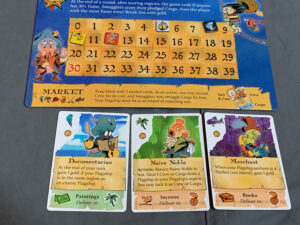
One thing that does muddy your decision-making process a bit throughout the game is the dice. That you’re rolling dice does matter, as the values are relevant. Many actions let you use any die, but those actions are the most basic. More specific actions have a number (or the word “even”) printed in their space on your board. This means you must use a die of that value in the slot. These are your key actions that help you advance your game plan. For example, the Mollusk Union requires a 1 for their Assemble action that lets them place a number of Comrades on their current island. You have some control here though, if the dice don’t help you out when you absolutely need to do those actions. When you go to place a die, you can spend an amount of gold to increase or decrease that die’s value by an equal amount, letting you manipulate your results a bit.

Gold is something you can accrue throughout the game from actions, but one of the ways that seemed easiest to get it was through battle. When you move into a space with another player’s units, there might be a battle. I say might because one side (at least) must have loaded cannons, usually by placing a die on their Cannons action on their board. If a battle does happen, both the attacker and defender roll battle dice and compare their results (which can be modified by reducing the value of the die in your Cannons slot on your player board). The winner can consult their player board for Battle Victory options, which deal damage to the loser (blocking an action space till repaired) and steal gold or advance your game plan.
The Mollusk Union and the Bluefin Squadron are really the core of the game here. They play very differently despite both working in an area control space mechanically. The Mollusk Union has Plan cards that you draw throughout the game that let you do unique effects at the right moment. They can help you in battle, give you a couple of additional ships to threaten control, or move your Comrades around and overwhelm the islands. While the Bluefin Squadron has naval superiority. They have up to 10 patrols they can move around the board in addition to their flagship and can build strongholds using the patrols.
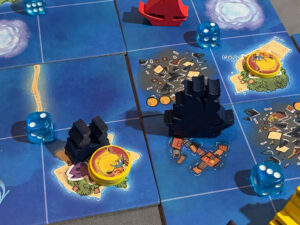
There’s a bit of a dichotomy with this game. It is really fun at 2 players. It is fast and whimsical. The first two factions, which you are instructed to always use in 2-player, are interesting and very distinct from one another. The 3rd and 4th player Smugglers, however, add less to the game and almost bog it down in a way. They don’t really have any specific interaction with the other players and they don’t factor into the area control. They collect cargo and move it to a matching island. They aren’t as interesting as the Bluefin Squadron or the Mollusk Union (they don’t even have a name!), and the two Smugglers are identical aside from color. That lack of depth to the asymmetry is a little odd coming from Leader Games. They almost feel like they are there just to increase the player count, especially due to the lack of theming compared to the main two.
I think that ends up not being a huge knock against it, since you can just play it with 2 players and call it a day. That’s where the game’s strength is and it is how I would recommend playing it every time. My thoughts on it ultimately are through that lens, as I don’t think 3-4 players really are worth considering here.
Final Thoughts
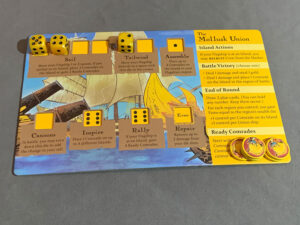
For a small 2-player game there is a lot of variety to be had with Ahoy. The small board expands and unlocks a lot of options and paths for you to try to achieve victory as the game progresses. With the board being modular, the setup is different every time. You never know where to expect the various terrain to be at the start of the game, and you have some agency in how it gets built due to getting to choose the orientation of each tile as you place it on your turn. Additionally, the crew cards that cycle throughout the game can get you different abilities and strengths from game-to-game.
As in many asymmetric games, when you first look at it, things might not entirely make sense and all the choices on your board might seem like they don’t matter. After you get going a few turns into your first game with each faction though, it starts to click how they work, what they want to do, and what each of the choices means to your faction specifically. Once you see that, it really flows smoothly, and the game is over in no time, despite the latter turns of the game being a bit denser than the earlier turns. You’ll probably want to set it up and try again (…as long as you were playing with only two).
Final Score: 4 Stars – At 2 players this is a fun and quick game with a cute theme, and nicely asymmetric gameplay. Would rate lower for 3-4 players.
 Hits:
Hits:
• THE MOLLUSK UNION! ARRRRRRRRGH!!!
• The modular board and the crew market cards add additional variety from game-to-game.
• The Bluefin Squadron and Mollusk Union have distinct and interesting gameplay, despite a shared mechanical objective.
• Fast!
Misses:
• The Smugglers don’t add as much to the game as the other factions, and the game just plays better at 2 players.
• There’s a bit of a learning curve for such a small game, and seeing what you need to be doing can be a bit daunting at first
• The rulebook is a bit vague on certain points, especially actions that don’t require dice, and could have used a bit more length/clarity.









